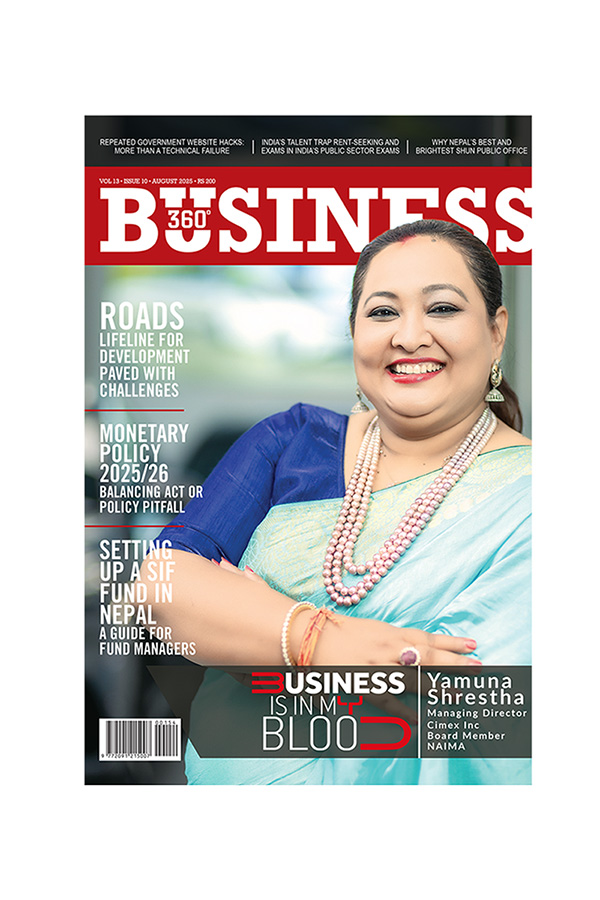
Running a business is a dynamic process in which individual companies and often whole industries rise and fall over a period of time. Such upheavals occur either as a result of relentless competition among firms or due to changing business climate in the country. Some particular firms that were vibrantly operating at one time lose ground and even disappear due to enormous challenges faced in keeping them running. In Nepal, some of the prominent garment industries like Momento Apparels and Cotton Comfort, disappeared from the market immediately after the phase-out of quota in 2005 while pioneering carpet industries were forced to cut down their production. The former case occurred due to loss of competitiveness of the Nepalese garment industries while the latter one is the fall out of reduction in the profit margin to the producers. Whatever carpet and garment industries are thriving in Nepal are running on razor thin profit margins.
In a market economy, competition and rivalry encourages firms to be more competitive and drive down cost which ultimately increases efficiency, enhances quality and benefits consumers. During the 50s and 60s, market was basically driven by sellers as products were limited to the hands of some producers giving less choice of goods and services to consumers. Rapid industrialisation of the developing countries and the contribution of advanced technology in production processes has enormously contributed to the diversification of products giving more choice to the consumers in the ensuing decades. Now consumer interest prevails in the market.
Markets also function on the premise of the income level of the common consumers who are large in numbers. Increment in the level of their disposable income means people are able to afford higher quality and quantity of goods. Higher level of consumption increases the aggregate demand that encourages producers to supply more by increasing their production. Increment in the sale and purchase of electronic and electrical appliances, and luxury goods including motor driven vehicles, cars and freezers in Nepal shows that people are earning more and the rate of affordability is increasing. The higher inflow of remittances, almost at the rate of 30% of GDP, is fueling imports of goods and services. But the big question is what will be the future of Nepalese economy if this trend continues to grow?
There is a dynamic movement of the production units and service providers due to globalisation of economies and facilitation of cross border movement of finance, goods and services. Investors move to those countries where there are possibilities of getting best returns on investment. Hence, countries are competing to attract foreign investment in order to improve the performance of their economy by creating exportable surplus and jobs to the people. Maintaining a business enabling environment is a big challenge for Nepal in order to enhance the flow of inward investment. This requires heavy investment in transport and energy infrastructures, transit facilitation, reform in policies and regulatory regimes and the promotion of good governance with transparency, accountability and rule of law.
Healthy competition is the key to successful business practices. Knowledge is one of the scarcest of all resources in any economy, and insight distilled from knowledge is even scarcer. Greater knowledge and insight translates into innovation which investors can use for better and efficient production processes. For example, the distribution network of consumer goods was very clumsy and inefficient until the great idea of selling merchandised goods through chain stores was propounded by Robert Wood of the Montgomery Ward in USA during the 1920s. This was a more efficient and more profitable means of selling goods and the concept became so popular in later years and many others like JC Penny, Wal-Mart, Best Buy and others came into existence in USA. Even in Nepal, now we can see people doing grocery shopping in retail chains like Bhatbhateni and Salesways rather than docking into small shops in their vicinity of their community. I ncreased transport facility, use of refrigerators and freezers by each household and reasonable pricing has attracted consumers to buy their stuff from such big retail chains.
The use of electronic commerce is again changing the landscape of doing retail trade. Online shopping is heavily reducing the cost of delivery as factory outlets directly deliver goods to the ultimate consumer eliminating the need of such retail stores. Consequently many such stores of Sears, Best Buy and JC Penny are either closed down or preparing to shut down their operations due to losses incurred. This innovation has reduced the cost of delivery to the benefit of consumers and suppliers.
Thus use of knowledge and technologies is prime in any economic decision making. In a controlled economy, people in the government and their cronies having less knowledge are giving orders to people having extensive knowledge on such subject matters. Keeping business alive, thus needs the use of extensive knowledge and research which largely comes from out of the government.
Nepal as a country on the low ebb of investment should focus on creating a sustainable manufacture base in order to expand export trade and substitute import of goods and services. High dependency on remittances and import based revenue may push the country to the precipice of economic crash. Government of the day should promote innovative production practices that can be achieved only by ensuring accountability, rule of law and meritocracy in overall governance system.
Published Date: January 19, 2018, 12:00 am
Post Comment
E-Magazine

